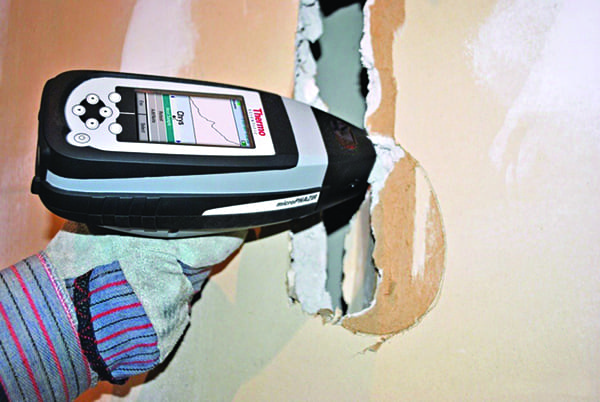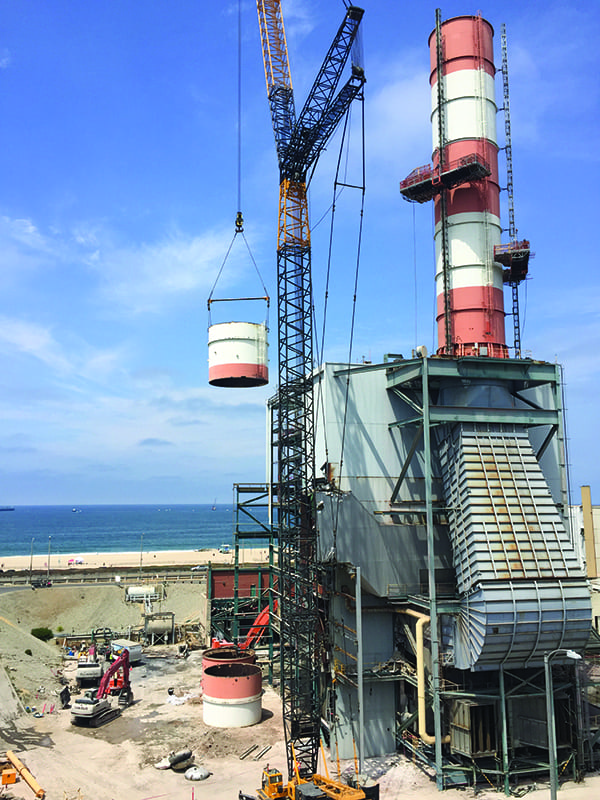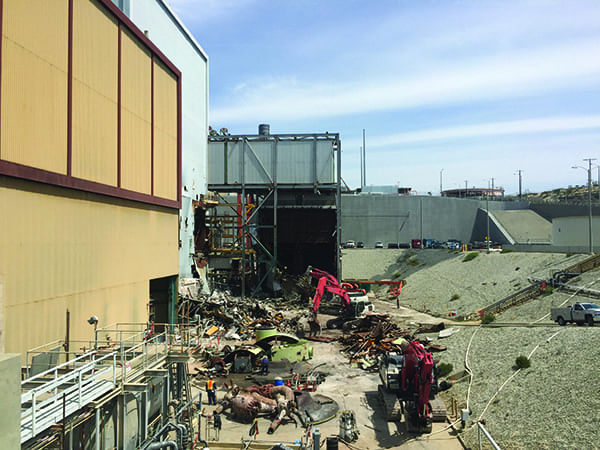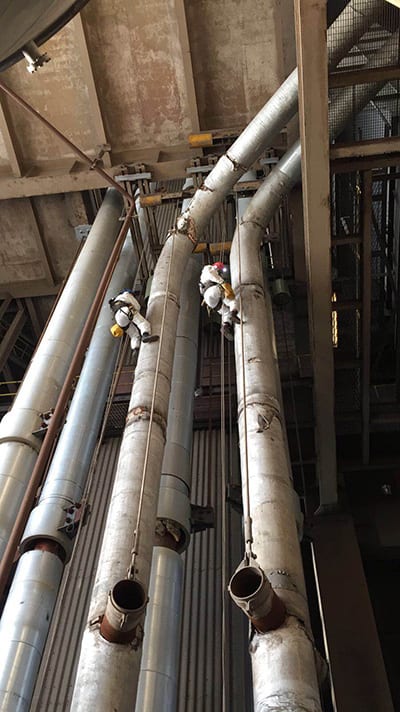Removing Asbestos and Regulated Materials Key to Power Plant Decommissioning
Retiring and decommissioning coal power plants is becoming a more-frequent occurrence around the world. The job comes with many challenges, but projects in the U.S. and UK have proven that remediation and redevelopment tasks can be completed successfully, beginning with the surgical removal of asbestos and regulated materials.
The coal industry has a lot going for it. There are federal and state-level efforts trying to keep the sector alive. The fuel is abundant. There is an estimated 1.1 trillion metric tons of proven coal reserves worldwide—enough to last about 150 years at current production rates. Furthermore, there are more than 700 GW of coal-fueled plants in development or under construction, according to the World Coal Association.
However, the U.S. coal industry faces steep competition from renewable energy resources and natural gas-fired generation. Statistics only reinforce perceptions of an industry in decline. For instance, the U.S. Energy Information Administration reported that U.S. power companies have retired more than 546 coal-fired units, about 102 GW, between 2010 and the first quarter of 2019, and intend to retire another 17 GW by 2025.
The Decision to Retire a Plant
When does a coal plant operator decide to retire a plant and pursue demolition, remediation, and redevelopment? Factors that have influenced retirement decisions include:
- ■ Regional electricity demands.
- ■ Regional power prices and economics.
- ■ Environmental regulation compliance and pollution control upgrades increasing operational costs, such as the Mercury and Air Toxics Standards rule.
- ■ Abundant and available natural gas supplies.
- ■ Favorable state tax and portfolio policies encouraging renewable energy.
- ■ Aging, low-efficiency, low-capacity, and fully depreciated coal plants.
- ■ Negative investor and public perceptions.
Eventual retirement decisions should not surprise power companies because two-thirds of states, either by statute or regulation, require plant operators to file Integrated Resource Plans (IRPs) or equivalent forecasts with their state public utility commissions. These long-term plans, with stakeholder and public input, present business strategies for meeting forecasted power demands. IRP requirements and scope can vary by state, but most consider a 20-year planning horizon.
Retirement, Decommissioning, Remediation, and Redevelopment
POWER interviewed Ed Malley, a vice president with TRC, about coal plant decommissioning and abatement activities following retirement. Malley commented that once a decision is made to close a coal plant, it takes about one year to evaluate demolition, remediation, and redevelopment options (see sidebar “Terminology”) to prepare competitive bid package specifications.
TerminologySeveral terms are often used interchangeably following the closure of a power plant, but they do have different connotations. Some common words and their meanings follow. Retirement. A plant is declared inoperable, that is, neither economically nor technically feasible to continue operating. This includes interim preservation methods until decommissioning can begin. Decommissioning. A series of activities to remove hazardous materials, such as asbestos abatement, and plant superstructure and infrastructure demolition. Remediation. Surface and subsurface property reclamation. Redevelopment. Designated end-use applications. |
Compared to operating license termination with nuclear plant decommissioning regulated by the U.S. Nuclear Regulatory Commission, there are no federal or state laws mandating conventional power plant decommissioning. However, there are requirements for what to do and how to do it through permits and notifications, using the U.S. Environmental Protection Agency’s (EPA’s) Clean Air Act citations.
It is well-known that asbestos was used in many older plants as a heat-resistant, thermal insulating material associated with the high temperatures needed to operate boilers and generate electricity. Asbestos is the generic commercial designation for a group of naturally occurring mineral silicate fibers of the serpentine and amphibole series. These include the serpentine mineral chrysotile (white asbestos), and the five amphibole minerals—actinolite, amosite (brown asbestos), anthophyllite, crocidolite (blue asbestos), and tremolite.
Malley said the EPA’s National Emission Standards for Hazardous Air Pollutants (NESHAPS) regulations (40 CFR 61.145, Standard for demolition and renovation) require a “thorough” asbestos survey prior to structural demolition. Also, a written notification of intent to the designated asbestos-regulating state agency to perform large-scale asbestos work, such as a coal plant, is required at least 10 calendar days before asbestos stripping or removal work such as breaking up, dislodging, or disturbing asbestos begins. Abatement activity fee schedules vary by state. The EPA’s asbestos regulation is intended to minimize asbestos fibers from being generated during handling and removal, thereby reducing health effects associated with asbestos exposure including lung cancer, mesothelioma, and asbestosis.
A Tiered Abatement System
Asbestos abatement worker protection and training requirements are established at the federal level by the U.S. Occupational Safety and Health Administration (OSHA) and the EPA. Furthermore, individual state requirements are similar to the federal regulations but can include stricter variations and provisions. The rules generally require asbestos abatement to be performed by licensed contractors. Some cities require a city-issued license. Also, companies must designate an abatement supervisor (referred to as an OSHA competent person in 29 CFR 1926.1101, Asbestos) capable of identifying asbestos hazards in the workplace and the authority to correct them.
The OSHA regulations use a graded approach when removing asbestos, with the majority of resources applied to Class I and Class II work prior to demolition. The classes are:
- Class I. Removal of thermal system (such as pipe) insulation.
- Class II. Removal of asbestos-containing wallboard, floor tile and sheeting, roofing and siding shingles, and construction mastics.
- Class III. Repair and maintenance operations where asbestos is likely to be disturbed.
- Class IV. Maintenance and custodial activities, where employees contact but do not disturb asbestos; and activities to clean up dust, waste, and debris resulting from Class I, II, and III activities.
Engineering, administrative, and personal protective equipment (such as respirators) prevent employee exposure and fiber dispersion. For example, ventilation and piping isolation is performed in connection with using negative-pressure enclosures sealed with tape and plastic sheeting; using high-efficiency particulate air (HEPA)-filtered vacuums, wet-cleaning, and glove bags; cutting nails or bolts with flat, sharp instruments; and decontamination enclosures (such as shower and clean rooms).
Employee Asbestos Monitoring. Asbestos air monitoring cassettes are used to collect worker breathing-zone air samples by measuring fiber content for a specific air volume in a stated time period. The cassette filters are analyzed using the National Institute for Occupational Safety and Health (NIOSH) Method 7400, Asbestos and Other Fibers by PCM (phase contrast light microscopy) or Method 7402, Asbestos by TEM (transmission electron microscopy). Different cassettes and NIOSH methods are available depending on the airborne hazard being monitored.
Workers are issued their own respirators according to the asbestos class and 29 CFR 1910.134, Respiratory Protection, to prevent inhalation of asbestos and other hazardous airborne constituents. Once abatement is completed, areas are decontaminated. Additional encapsulation can be applied using a lockdown sealant, with area air samples confirming final clearance criteria.
microPHAZIR AS Asbestos Analyzer. Typical asbestos sampling can take seven to 10 business days, costing $5 to $20/layer for polarized light microscopy analysis and $50 to $150/layer for TEM analysis, depending on turnaround time. The Thermo Scientific hand-held, near-infrared (NIR) spectroscopy microPHAZIR AS asbestos analyzer enables rapid (3 to 5 seconds) and qualitative in-field identification of all six regulated asbestos fiber types. Similar in concept to an X-ray fluorescence (XRF) device analyzing for lead in paint, the microPHAZIR AS (Figure 1) can scan ducting, pipes, boilers, wallboard, flooring, and ceiling tiles without disturbing and releasing asbestos into the environment.
 |
|
1. The microPHAZIR AS asbestos analyzer is a powerful tool that enables in-field, rapid screening and identification of asbestos within seconds. Courtesy: Thermo Fisher Scientific |
Regulated Materials Survey
Asbestos is not the only danger encountered during decommissioning activities. A hazardous and regulated materials survey includes checking for heavy metals and polychlorinated biphenyls (PCBs). Lead-based paint was widely used before 1978, and contained as much as 50% lead by weight prior to the 1950s. Mercury can be found in switches, instrumentation, and pressure-vapor lighting. PCBs were used in capacitors, transformers, and fire-retardant materials. Handling and disposal requirements for PCBs, are regulated by the Toxic Substance Control Act (40 CFR 761, Polychlorinated Biphenyls [PCBs] Manufacturing, Processing, Distribution in Commerce, and Use Prohibitions).
Similar to asbestos worker protection, lead-safe work practices (29 CFR 1926.62, Lead) minimize exposure from dust and debris generated during demolition. These universal practices include wearing proper personal protective clothing, respiratory protection, and using containment structures connected to HEPA-filtering machines. Once the asbestos and regulated materials are removed, structural demolition and site decommissioning can proceed. Some materials, such as non-friable asbestos-containing roofing may be left intact during demolition while using engineering controls such as water spray to prevent environmental releases.
Wastewater
Although there is a reduction or cessation of wastewater discharges following retirement, the National Pollutant Discharge Elimination System (NPDES) permit must be revised to account for discharges during demolition and remediation. Malley commented that the engineering group often manages the physical deconstruction of the building and equipment.
The environmental group typically addresses coal ash, whether in ponds or sludge, wet or dry. In the past, coal ash was deferred because there was no regulatory requirement, but that changed when the EPA promulgated coal ash regulations in 2016.
Deconstruction and Demolition
The deconstruction and demolition process can be inherently complex compared to a plant’s original construction profile, accounting for structural and pollution control modifications during its lifetime. Although a coal plant is offline, along with shuttered precipitators, boilers, turbines, and generators, electrical power must be maintained to essential systems, such as communications, life safety codes, elevators, cranes, and Federal Aviation Administration stack lighting affecting navigable airspace until the stack is removed. Certain city fire departments require sprinkler systems to be operational one level below demolition. For example, if demolishing the 10th floor, the sprinkler system must be live to the 9th floor.
Similar to the strategic removal of asbestos and regulated materials, parallel activities include a combination of depressurizing, venting, flushing, draining, and isolating systems. For example, pipes can be cleaned using a series of foam, bullet-shaped “pigs,” slightly larger compared to the pipe’s inside diameter. Tank bottoms can be removed using mobile vacuum trucks, and the cleaning wastes can be treated and recycled.
Flammable and asphyxiating gas release points must preclude work area encroachment. Air gapping is a visually confirmed, physical separation of hazardous energy sources from the work area when lockout/tagout is neither feasible nor necessary. Examples include confirmed separation of wiring conduit and end-capped pipes.
Site Coordination on a Small Footprint
TRC served as general contractor for the $26 million decommissioning and razing of the Los Angeles Department of Water and Power’s Scattergood Unit 3 (Figures 2 and 3). It was completed with no impacts to the adjacent 830-MW natural gas-powered Scattergood Units 1 and 2, which were only about 100 feet away. Distinct and overlapping activities were completed during the 17-month schedule, including hazardous materials removal (three months), asbestos abatement (six months), and demolition (seven months). The project finished three months early.
 |
|
2. Scattergood Unit 3’s 334-foot-tall stack was removed in 20-foot sections using self-erecting scaffolding. Courtesy: TRC |
 |
|
3. Demolition work on Scattergood Unit 3 was completed within a tight 1.5-acre footprint without disrupting power from Unit’s 1 and 2. Courtesy: TRC |
As part of the project, TRC’s building sciences teams verified special hazardous materials handling—including asbestos, lead, petroleum oil, PCBs, and radioactive components—were completed safely. There were no OSHA recordable injuries during the 662-day project (including post-demolition activities), translating to 100,000 man-hours worked.
A crawler crane was used to set a 160-ton gantry crane and portions of the original structure on the ground for sizing into manageable pieces. Assessing the structural integrity and pipeline crossings of a sectioned structure weighing several thousand tons is essential for proper hoisting and rigging operations. Malley mentioned that the process required lowering structural sections to grade for sizing, using ground-based equipment for either disposal or reuse/recycling. These engineered lifts considered sectioned weight and dimensions, rigging and lift points, center of gravity, working radius, and contingency factors to ensure they were within the crane’s lifting capacity. Miscalculations can result in an unstable load contacting the crane boom or dropping the lift.
Typical cold-cutting methods used for sizing structures include:
- ■ Hydraulic shears and reciprocating saws for sizing pipe materials.
- ■ Diamond wire sawing, which utilizes an endless-loop wire rope impregnated with industrial diamonds fed through holes drilled into concrete structures.
- ■ Hydraulic splitters, which are insertion and expansion tools for cracking concrete.
- ■ Impact demolition, which uses hydraulic-powered impact hammers operated from excavators or wrecking balls.
- ■ Explosives, which are often used to topple stacks and reduce structures to rubble.
Since the 55-acre Scattergood Generating Station is directly across the street from Dockweiler State Beach and the Pacific Ocean, nuisance dust and visible emission control measures (such as water spray) were used to prevent releases beyond the site boundary. Also, controlling heavy truck traffic entering and existing the site eliminated disruptions to pedestrian foot traffic. In addition, some activities were only performed during certain hours, such as between 7 a.m. and 7 p.m., to prevent noise and vibration impacts to local stakeholders.
Scrap Has Value
Considering a 500-MW coal plant can have about 15,000 tons of recoverable steel and a million pounds of copper, scrap streams hold significant value. Malley said that the out-of-pocket costs of removing asbestos, regulated materials, and the $3 million to $5 million per boiler-turbine unit, can be significantly offset by the scrap value (see sidebar “Coal Phaseout in the UK”). There are a variety of ways to divide the scrap recovery dollars between the plant owner and demolition contractor, but TRC has found it is most efficient to assign the money to the contractor because it is handling the scrap.
Coal Phaseout in the UKThe International Energy Agency reports that the UK is transitioning to a low-carbon economy by phasing out all remaining unabated coal-fired power generation by 2025. By 2030, wind and solar are expected to reach above 50% in the UK, more than in any other country. Stuart Goodman, national utilities contract manager with Lucion Consulting, and Dave Cooper, Lucion’s commercial director, provided POWER with insight on this phaseout and how approaches to coal plant decommissioning and demolition—beginning with asbestos and regulated material removal—are similar worldwide. UK coal-fired plants, ranging from 500 MW to 660 MW, were designed and built predominantly in the 1960s and 1970s for a nominal 25-year design life, equivalent to 250,000 operating hours. Decommissioning and demolition planning can take three to five years in the UK, and field activities must comply with the Health and Safety at Work Act 1974, an enabling act creating a number of decommissioning and demolition subsidiary regulations. These include: ■ Management of Health and Safety at Work Regulations (1999) ■ Control of Asbestos Regulations (2012) ■ Control of Substances Hazardous to Health Regulations (2002) ■ Work at Height Regulations (2005) ■ Confined Space Regulations (1997) ■ Lifting Operations and Lifting Equipment Regulations (1998) Lucion successfully completed asbestos and hazardous insulating material demolition surveys at three coal-fired power stations. One survey—the largest to date, having a value of £450,000 ($540,000)—required accessing all station areas, including four 500-MW turbines, eight cooling towers, boiler houses, pumping stations, and chimneys. Instead of relying on mobile elevated work platforms and scaffolding to reach high-level areas, surveyors used rope access systems (Figure 4). The Industrial Rope Access Trade Association provides various qualification levels based on training and logged hours. In this case, 15 surveyors were assigned to a 10-week contract, with a number of them being Level 1 rope-qualified and assisted by Level 3 rope-qualified operatives.
Over 13,000 samples were analyzed, identifying asbestos-containing materials (ACMs) using an ISO 17025 laboratory approved by the UK’s national accreditation body. Core samples were collected through the boiler house and turbine hall concrete raft (floor) determining if asbestos was within or below the raft. Enclosures, sprays to control dust, and air monitoring were used when removing ACMs in poor condition to prevent survey team and site worker exposure. Sampled materials identified cristobalite, refractory ceramic fibers, and ozone depleting substances. Sampling water/sludge from cooling tower ponds analyzed for total variable count—a microorganism concentration estimate—identifying the likelihood of legionella and potentially hazardous bacteria. Once the asbestos and hazardous materials were removed, demolition could begin, with arrangements addressing inaccessible areas and unexpected discoveries. Some post-demolition ground gas and water monitoring may be required if contaminated land is identified. Costs can vary significantly from plant to plant, depending on age, structure, and ACMs to be removed. However, the asbestos survey (£500,000) and removal (£5 million to £15 million) are often the most significant, but can be countered by recycling scrap components. |
Future Land-Use Strategies
An environmental site assessment consisting of a non-invasive data-gathering process based on site history (ASTM E1527-13, Standard Practice for Environmental Site Assessments: Phase I Environmental Site Assessment Process), followed by confirmatory, intrusive sampling and analysis (ASTM E1903-11, Standard Practice for Environmental Site Assessments: Phase II Environmental Site Assessment Process), can confirm that a planned redevelopment scenario is technically and financially feasible. These Phase I and II assessments help buyers and sellers manage and allocate environmental risks, so that recognized environmental concerns can be mitigated. Remediation—referred to as Phase III—focuses on confirmed areas of known impact, and takes specific actions regarding future land-use strategies, such as installing monitoring wells to track underground storage tank plume migration.
A site’s proposed redevelopment determines the removal of underground components such as sumps and foundations. Recontouring, grading, backfilling sumps and basements with demolition debris (such as brick or concrete), drainage control, and revegetation promotes stabilization, returning the area to its original state. Even partial site decommissioning can add significant value for companies and communities, such as structural preservation and recognition as a National Historic Preservation Act landmark.
Some sites are sold as-is to developers. Developers will often pursue site plan approvals for redevelopment prior to abatement and demolition. Once site plans are approved, developers may proceed with financing decommissioning as a project cost along with buildout of new structures. Once demolition is complete and the site remediated, the operator can proceed with redevelopment. ■
—James M. Hylko ([email protected]) specializes in safety, quality, and emergency management issues and is a frequent contributor to POWER.
[Ed. note: According to The Mesothelioma Center, mesothelioma is a malignant tumor that is caused by inhaled asbestos fibers and forms in the lining of the lungs, abdomen, or heart. Symptoms can include shortness of breath and chest pain. More than 3,000 cases of mesothelioma are diagnosed yearly in the U.S. The average age of mesothelioma patients is 69. To learn more about mesothelioma, visit: www.asbestos.com/mesothelioma/. For additional information about the types of mesothelioma, risk factors, symptoms, diagnosis, stages, prognosis, treatment options, cost of treatment, and possible legal recourses for individuals exposed to asbestos, visit: www.lanierlawfirm.com/mesothelioma/.]
